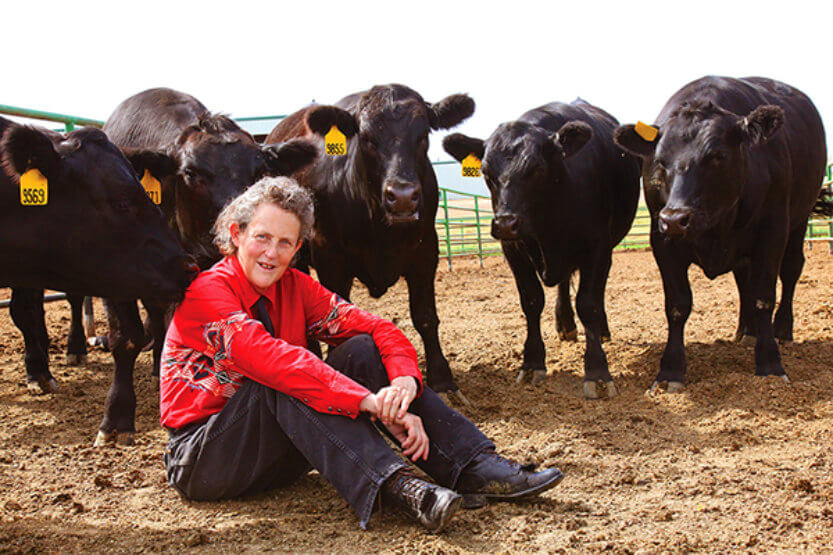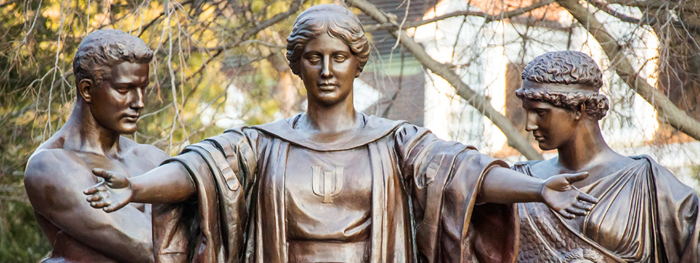Alumni Interview: Temple Grandin
 “I’m a big advocate of breaking down barriers, working with people who are different, whose brains work differently,” says Temple Grandin, PHD ’89 ACES, HON ’04, a professor of animal science at Colorado State University. (Image by Rosalie Winard)
“I’m a big advocate of breaking down barriers, working with people who are different, whose brains work differently,” says Temple Grandin, PHD ’89 ACES, HON ’04, a professor of animal science at Colorado State University. (Image by Rosalie Winard) I got my master’s degree in animal science at Arizona State University. I went there to study cows. I had come a long way in my development by then. I didn’t speak until I was 4, and many doctors had advised my mother to institutionalize me.
I faced a new kind of adversity as a woman in a man’s world in Arizona during the early 1970s. There were no women on the feed lots. I don’t know how many even wanted to go there, but the men certainly made it clear that they didn’t want me there. They even threw bull testicles at my vehicle. I refused to quit. I began to write articles for a publication called Arizona Farmer-Ranchman—that gave me credibility, and even some acceptance.
My autism led me to insights about what the cows in those lots were going through. Some people said, “Temple thinks like a cow.” I don’t know about that, but I know that my brain works differently than most. Words and verbal concepts are a second way of thinking for me. I think primarily in pictures, and because of that, I saw what the cows were seeing, and connected that to how they were behaving. I was one of the first scientists to report that animals are sensitive to distractions in handling facilities like a dangling chain or a cowboy’s jacket on a fence rail. The cattle’s fear causes them to panic, which leads to injuries and losses.
I think primarily in pictures, and because of that, I saw what the cows were seeing, and connected that to how they were behaving.
I developed a good business designing facilities that were less threatening to the livestock. In North America, for example, almost half of all large cattle-processing facilities include a center track restrainer system that I designed. But in the early 1980s, business was pretty slow, so I thought it would be a good time to get my Ph.D., and I came to UI.
I took some super courses at Illinois. One of them—Psychology 217, William Greenough’s Introduction to Neuroscience and Animal Behavior—was the best course I ever took. I loved it! And it wasn’t even a graduate-level course, so I didn’t get any credit.
Dr. Greenough had developed a hypothesis about how environments affect animals. He believed that environments that are more complex lead to more connections in the visual cortex of the brain. I did an experiment where I put one group of pigs in simple plastic pens, and another in a Disneyland for pigs. The latter got fresh straw every day and stuff to play with. The hypothesis was that those pigs would have a more complex visual and somatosensory cortex (the part of the brain that receives sensation from the snout). I took a lot of samples, spent hours poring over a microscope, and in the end, the results were backwards. Backwards! The pigs in the plastic pens had more complex nerve-ending branching. Bill had two words: “Oh s**t.”
We repeated the experiments, but this time we put cameras on the pigs. We discovered that at 3 a.m., the Disneyland pigs were sleeping, but the pigs in the plastic pens were up, constantly grinding their noses both into the floor and into each other. In the visual cortex, there was no effect, but in the somatosensory cortex, there was more abundant dendritic branching. It was the pigs using their snouts that led to dendritic development.
There were things I learned at Illinois that I continue to use with my students at Colorado State University. I’m a big advocate of breaking down barriers, working with people who are different, whose brains work differently.
I do a lot of speaking these days, often at big tech companies. I can look into the audiences and see many people who are on the autism spectrum, creative people who maybe aren’t very social but whose minds work in amazing ways. Autism is a continuum. On one end are kids who are non-verbal; on the other end are brilliant scientists and artists. Einstein, Mozart, Tesla—they would all probably be diagnosed as [being] on the autistic spectrum today. Steve Jobs was probably on the spectrum. The question that most concerns me is, how can we help these brilliant kids excel, so that they can create inventions and breakthroughs? We need their abilities to discover solutions for a better tomorrow.

